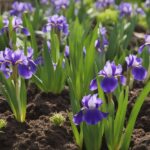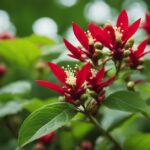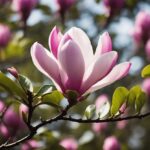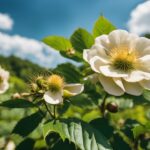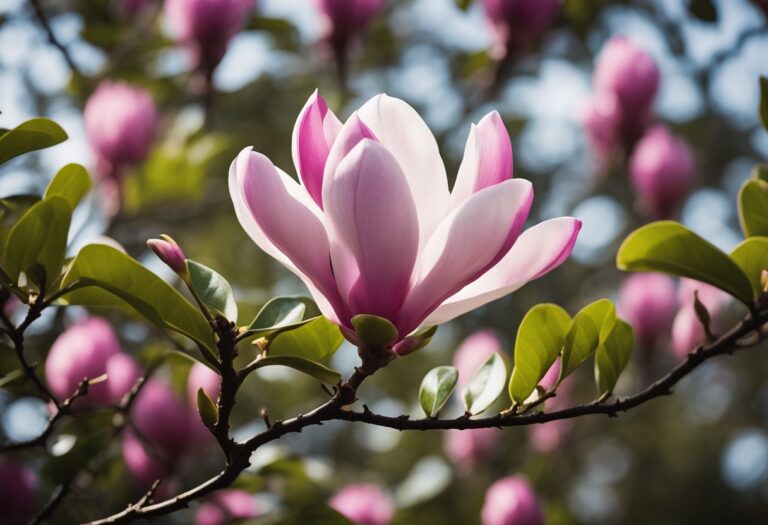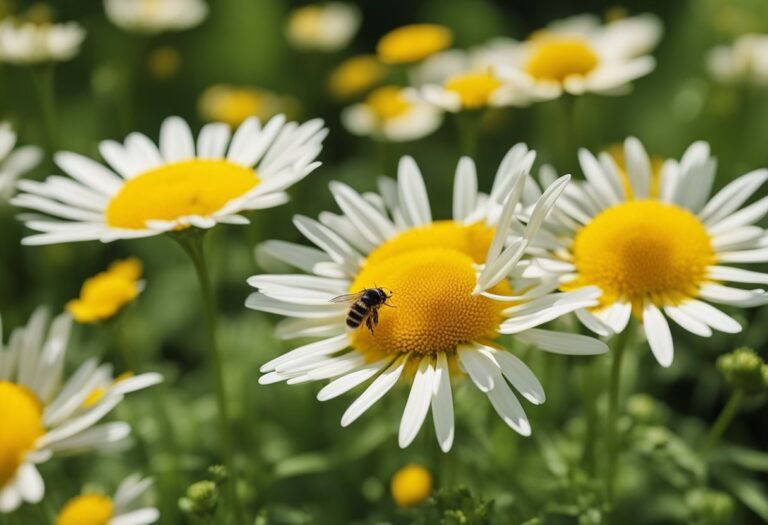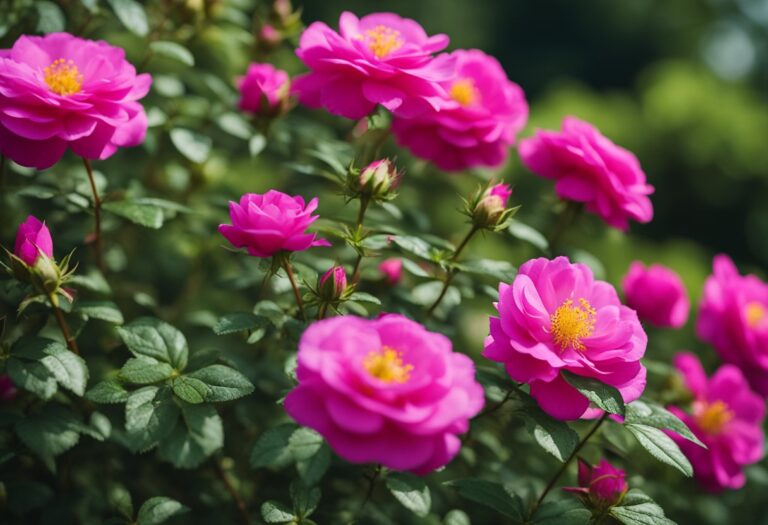Overview of Magnolia ‘Jane’
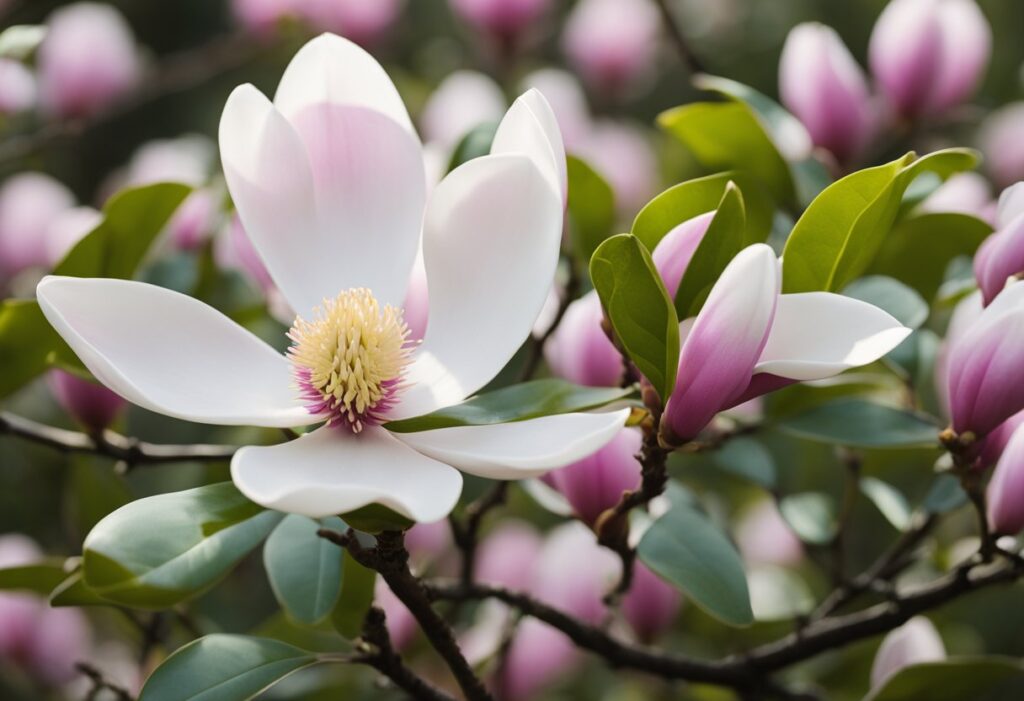
Magnolia ‘Jane’ is a hybrid member of the diverse Magnolia family, known for its compact size and striking floral display. Developed in the 1950s at the U.S. National Arboretum, this variety is part of the “Little Girl” series, offering a robust option for smaller gardens where space may be limited.
Your Magnolia ‘Jane’ will flourish best when planted in a sunny location with a minimum of six hours of unfiltered sunshine daily. However, water it adequately, especially as the plant establishes itself. Over time, it will transition to moderate drought tolerance. Enrich your garden’s soil with organic matter to ensure proper drainage and nutrients for your magnolia.
Key Characteristics:
- Bloom Time: Embraces early spring with vibrant flowers.
- Growth Habit: Features a neat, compact shape suitable for smaller areas.
- Size: Typically a small tree or large shrub reaching manageable heights.
- Flowers: Showcases large, tulip-shaped blooms ranging from purple to pink, with white interiors.
Your maintenance routine should include occasional pruning only to maintain its shape and remove any damaged or crossed branches. This practice will promote healthy growth and enhance the plant’s natural form.
Remember, Magnolia ‘Jane’ is resilient. It can withstand colder climates that challenge other magnolia species while also being able to endure summer heat, provided it has adequate protection from harsh afternoon sun.
Cultivation and Care
Understanding the specific requirements for planting, watering, and routine maintenance is crucial to ensure the vitality of your Magnolia ‘Jane’.
Planting Requirements
Your Magnolia ‘Jane’ will thrive in USDA zones 4 to 8, benefiting from a location that offers full sun to partial shade. Ideal soil conditions are well-drained and rich in organic matter. When planting, ensure that the hole is twice the width of the root ball and equal in depth.
- Sunlight: Full sun to partial shade
- Soil Type: Rich, well-drained soil
- USDA Zones: 4 to 8
Watering and Nutrients
Regular watering of your Magnolia ‘Jane’ is paramount, particularly during the first growing season, to establish a strong root system. Watering should be done weekly—about two to three times. Check the top 2 to 4 inches of soil for dryness to measure when to water. As the tree matures, its water requirements will diminish. For nutrients, you can apply a balanced fertilizer in the spring before new growth appears.
- Watering Frequency: Weekly (2-3 times)
- Check Soil Moisture: Top 2 to 4 inches
- Fertilization: Balanced fertilizer in early spring
Pruning and Maintenance
Pruning should occur in late winter to early spring to avoid removing any of the current season’s flowers. Focus on removing dead or crossed branches to maintain proper airflow and structure. Inspect the tree’s shape and make corrective cuts to maintain its ornamental appearance.
- Pruning Time: Late winter or early spring
- Maintenance: Remove dead/ crossed branches for tree health
Growth Habit and Characteristics
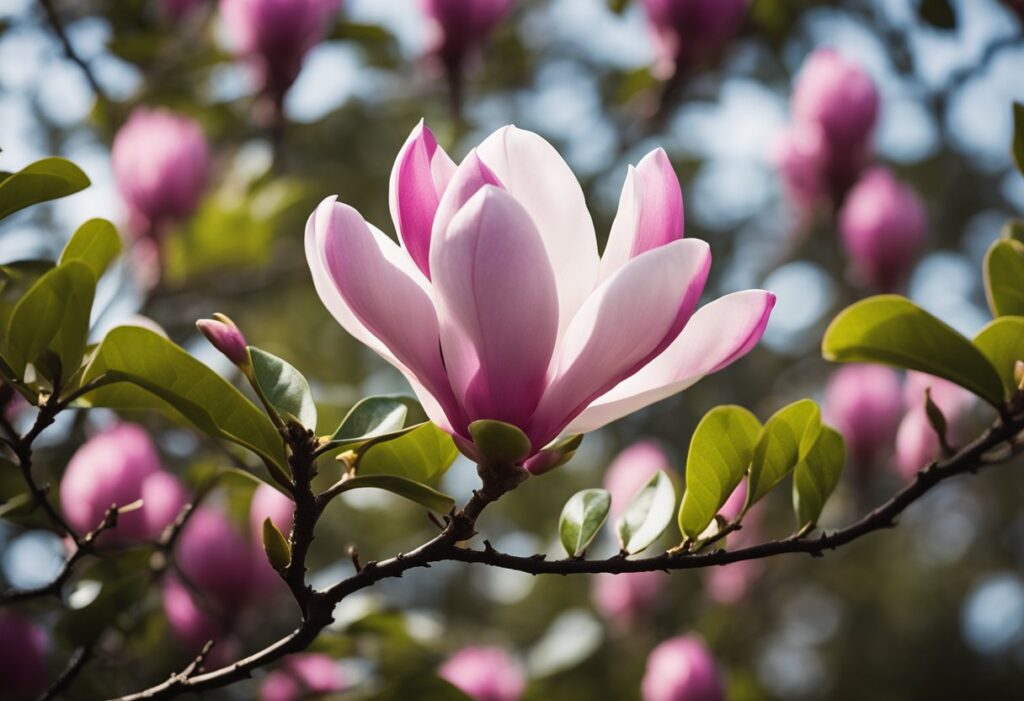
Your ‘Jane’ Magnolia is a well-adapted shrub with distinctive characteristics that ensure a beautiful garden presence through its growth and seasonal appearances.
Flowering and Foliage
Flowers: You’ll observe large, tulip-like purple flowers with white interiors that bloom prolifically in early spring before the foliage unfolds. Foliage: Following the blooming period, the ‘Jane’ Magnolia develops dark green leaves that provide a lush backdrop during the summer.
Height and Spread
Height: A mature ‘Jane’ Magnolia typically reaches 10 to 15 feet.
Spread: The spread is usually proportional to the height, providing a compact and rounded form to your shrub or small tree.
Hardiness Zones
The ‘Jane’ Magnolia is hardy and can be grown successfully in USDA Zones 4 to 8. This indicates that your plant can withstand various climates, from cold winters to moderate summers.
Landscaping Uses
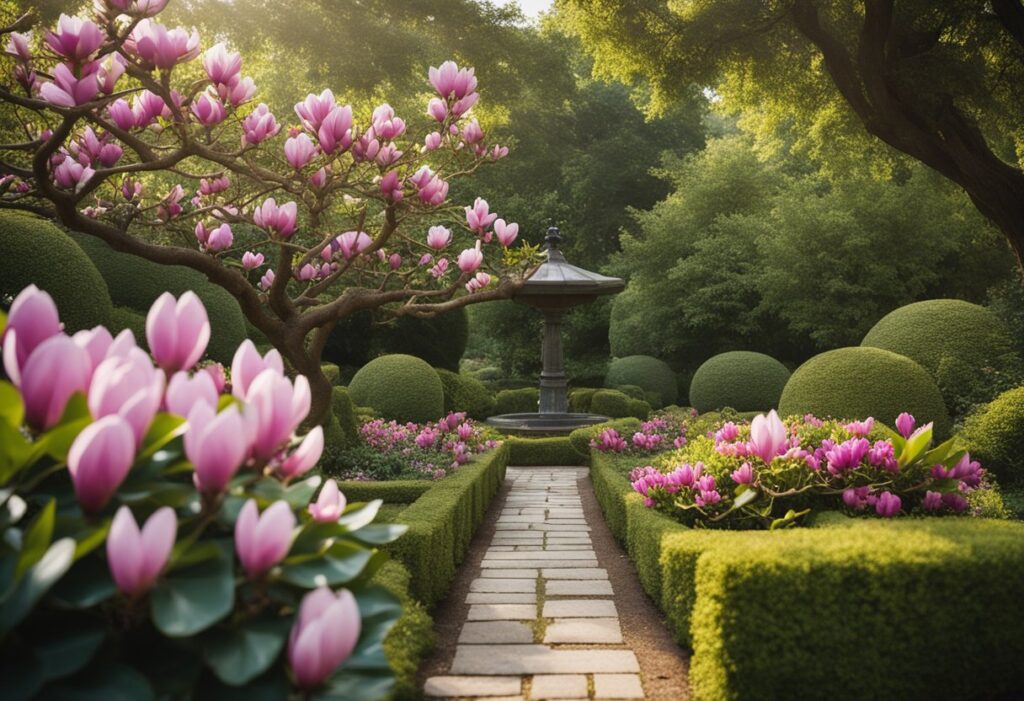
When considering the Magnolia ‘Jane’ for your landscaping, understand that its compact size and stunning spring blooms make it an ideal focal point. This magnolia variety is well-suited for small gardens and can enhance your outdoor space.
- Accent Features: Incorporate ‘Jane’ magnolias as stand-alone accent trees to captivate visitors with their large, tulip-shaped, purple-pink flowers.
- Border Plantings: Planting a row of ‘Jane’ magnolias can create an elegant border that provides privacy.
- Foundation Plants: Positioning ‘Jane’ near your home can soften the building’s edges, but remember to allow sufficient space for growth.
Care Tips for Landscaping:
- Watering: To establish a strong root system, routine watering is necessary, especially in the first growing season.
- Soil: Ensure the soil is well-draining but retains adequate moisture.
- Sunlight: ‘Jane’ performs best in areas with full sun to partial shade.
- Pruning: Minimize pruning to maintain the tree’s natural shape, only cutting away dead or damaged branches.
With a yearly growth rate of less than 12 inches, ‘Jane’ magnolias need strategic placement. Plan for maturity, giving space for spread and height potential, preventing future overcrowding, and reducing the need for relocation.
Propagation Methods
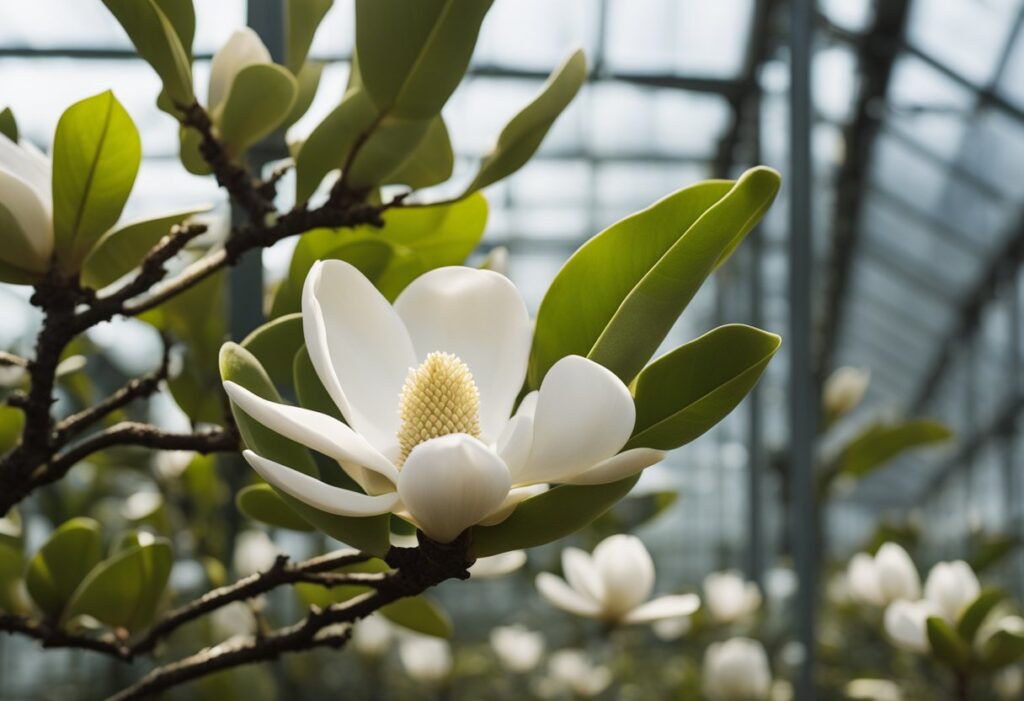
There are two primary methods of propagating your Magnolia ‘Jane’: seeds and cuttings. Each method has its own steps and requires certain conditions to increase the likelihood of successful propagation.
Seed Propagation:
- Collect Seeds: In the early autumn, look for the bright-red berries on your Magnolia ‘Jane’. These contain the seeds for propagation.
- Preparation: Remove the red outer coating of the berries to access the seeds.
- Sow: Plant the seeds in a well-draining soil mix and lightly cover them with soil. To break dormancy, they will need a period of stratification or cold treatment.
Cutting Propagation:
- Timing: Take cuttings from your magnolia tree in summer after the buds have set.
- Cutting Selection:
- Choose healthy, non-flowering shoots.
- Cut 6 to 8 inches of the growing tips.
- Preparation: Sterilize your cutting tool with denatured alcohol to prevent the spread of diseases.
- Rooting:
- Place your cuttings in water immediately after cutting.
- Dip the cut end into a rooting hormone.
- Insert the cutting into a pot filled with a mixture of peat and perlite.
- Environment: Keep your cuttings in a warm, humid environment to encourage root development.
Table 1: Summary of Propagation Methods
| Method | Medium | Time of Year | Preparation |
|---|---|---|---|
| Seed | Soil mix | Early autumn | Seed cleaning & sowing |
| Cutting | Peat and perlite | Summer | Cut, hormone, & plant |
Frequently Asked Questions
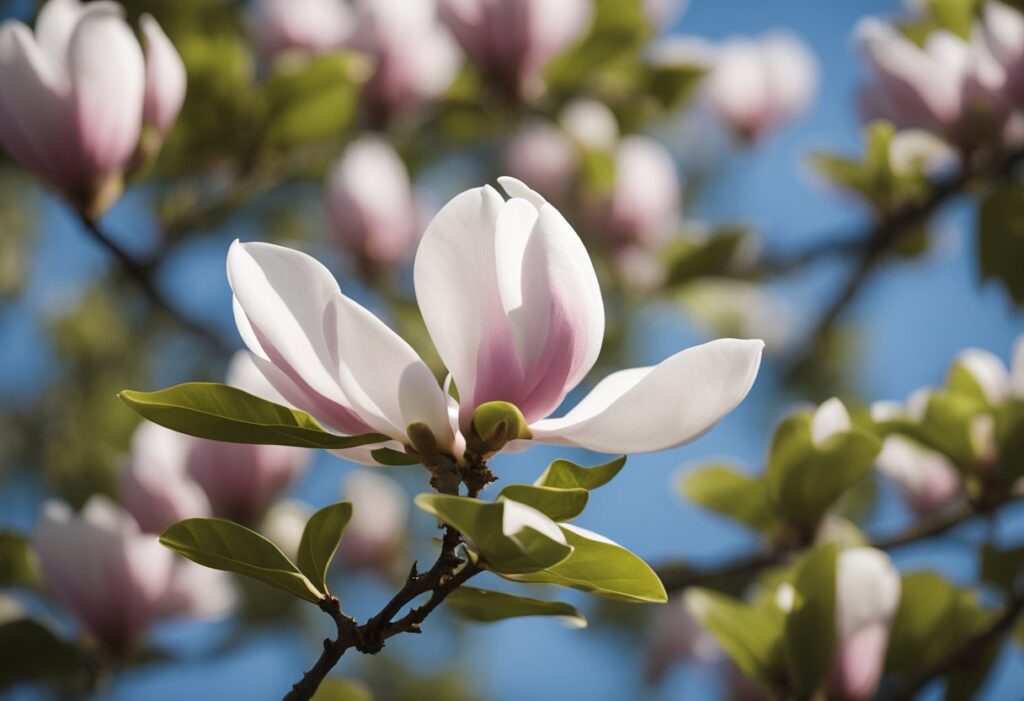
In this section, you’ll find targeted information addressing common inquiries around Magnolia ‘Jane’, a popular flowering tree known for its vibrant blossoms and hardiness.
How does ‘Jane’ compare to ‘Ann’ in the Magnolia varieties?
Magnolia ‘Jane’ typically produces pink-purple flowers and maintains a compact size suitable for small gardens. On the other hand, ‘Ann’ has similar care requirements but features reddish-purple flowers and can add a touch of elegance to any space with its sturdy nature.
What are the advantages and disadvantages of planting a Magnolia ‘Jane’?
The advantages of planting a Magnolia ‘Jane’ include its cold-hardiness, making it suitable for a range of climates, and its proliferation of large, colorful blooms even in colder regions. However, the tree has a shallow root system that requires mindful placement and maintenance to avoid damage from root growth.
In which USDA zones can Magnolia ‘Jane’ thrive?
Magnolia ‘Jane’ is hardy in USDA zones 4 to 8, enabling it to withstand various climates from colder northern areas to warmer southern locales.
What common issues should one be aware of when caring for a Jane Magnolia tree?
Key issues include ensuring proper sunlight exposure, ideally six hours of unfiltered sunlight, and maintaining well-draining soil. Once established, the tree is fairly drought-tolerant, but it’s crucial to maintain regular watering during development.
What is the expected growth rate for a Jane Magnolia?
The Jane Magnolia has a moderate growth rate of 1-2 feet per year, allowing for a relatively quick establishment without becoming too large.
What are the optimal conditions for planting a Jane Magnolia tree?
Plant your Jane Magnolia in a sunny spot with rich, well-draining soil for optimal growth. The planting hole should be wider than the root ball and shallower to promote proper root development.
Remember to water the tree regularly in the early stages until it becomes more drought-tolerant.


